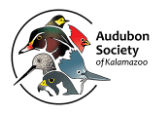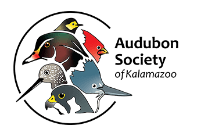Why Do We Care About Peregrine Falcons?
History and Conservation
During the mid-1900s, organochloride pesticides, such as DDT were widely used to control insect damage to crops. DDT accumulates in the food chain when poisoned insects are eaten by smaller birds, which are then eaten by larger birds of prey. DDT accumulates in the fat tissue so is not quickly or easily eliminated from the body once it is consumed. Peregrine Falcons became one of the most contaminated species of birds, and many died from these pesticides. Organochlorides are endocrine disruptors and the buildup of DDT causes hormonal changes that result in thin eggshells that break during incubation. DDT also affects the birds’ behavior so that they are less capable of taking care of their young, even if they do successfully hatch.
A survey of nesting sites estimated that the eastern US population in 1940 was only 350 pairs of peregrines. Historically, there were 13 known nesting sites in Michigan, located mostly in cliffs in the Upper Peninsula. The last known successful nesting in Michigan, prior to the restoration initiative, was in 1957 in Delta County. The world population of peregrines, as well as other birds of prey, including the Bald Eagle, plummeted in the 1950s due to the use of DDT. In 1965, no Peregrine Falcons were fledged in the eastern or Central United States, and by 1968, the entire peregrine population east of the Mississippi had disappeared. Peregrine Falcons were listed as an endangered species by the US Fish and Wildlife Service in 1970 and were then included in the first list of endangered species under Michigan’s Endangered Species Act. The use of DDT was banned in Canada and Europe in 1970 and in the US in 1972. The Eastern Peregrine Recovery Team was created in 1975. This team was charged with the task of developing a management plan to restore peregrines as a nesting bird population in the eastern US. The plan included captive breeding programs and reintroduction into traditional peregrine habitat. The recovery of this species was possible, in large part, because of private conservation efforts. In 1970, the first large captive breeding program at Cornell University, Ithaca, NY, was undertaken by the newly formed non-profit organization, The Peregrine Fund. Other captive breeding facilities were later developed. Due to the success of this effort, Peregrine Falcons were removed from the list of federally endangered species in 1999. Peregrine falcons were on the Endangered Species List in Michigan until 2023 when they were moved to the Threatened category. They are still protected by the Michigan DNR and are federally protected under the Migratory Bird Treaty Act. The US population of Peregrine Falcons consists of intergrades of multiple subspecies, including F. tundrius, F. anatum, and F. pealei. The post restoration population of Peregrine Falcons in the eastern US is a product of introduced and human-manipulated lineages; therefore are not a true subspecies. These birds are referred to as the Eastern Peregrine Falcon.
Continued threats to peregrines include Avian influenza which is usually fatal for raptors such as falcons. Window collisions, as well as collisions with power lines and other structures are a frequent hazard. Exposure to avicides, as a result of eating smaller birds that have been poisoned by products intended to control nuisance birds populations, such as pigeons in urban settings is a potential threat. Chemical contamination persists as a potential issue. Although the use of DDT is banned in the US, it is still in use in several other countries, and Peregrine Falcons and their prey species that winter outside the US may be susceptible to contamination.


